Ostrich is Biologically Highly Interesting and Useful for Human Life as a Producer of Antibiotics
Received: 09-Apr-2018 / Accepted Date: 18-Apr-2018 / Published Date: 25-Apr-2018
Abstract
Animals are exposed to the changing environments. Animal evolution is a kind of the accumulated memories of biological adaptions to the surrounding nature. Changing nature produces tremendous variations in biological kingdom.
Keywords: Ostrich; Animal evolution; Antibiotics; Biological adaptions
Introduction
Adaptation
Animals repeated adaptation to always changing environments of the changing nature on the earth. Animal history is the adaptation to changing nature. Usually it is believed that adaptation to nature proceeds only slowly [1]. It is called evolution. We have a feeling of slowly progressing adaptive changes of animals. Recently the speed of changes in environments is accelerated. A sudden environmental change occurred for ostrich about 160 years ago because of the domestication [2].
Self-Guard and Protection
The huge ratite birds, ostrich, had ever lived in the huge areas of Africa, Arabia and Asia. They were exposed to external stresses by carnivorous animals [1]. Wild dogs (lycaon) stole their eggs in nature. African vulgers carried edged rock fragments, dived toward ostrich eggs and bombed them (Figure 1). Ostriches developed huge and thick egg shells to protect their next generation. Once, domesticated they start to live in safe and guarded areas. Drastic changes occurred for ostriches. They have enjoyed a safe life guarded from dangerous environments. Grooves and ridges run alternately and are twisted. Most pores (dark dots in figures) are situated in the bottom of grooves [2]. The corrugated structure makes the shell more resistive against destructive forces probably. Recent eggshells show only random distribution of respiratory pores and seem to be thinner and more fragile. But it is still hard for new chicken to break open their own eggshells. About 20% of the newly hatched ostrich chicken suffers from troubles in legs. One short groove crosses other grooves obliquely downward. The cause for it remains unknown (Label No. 25755).
Domestication probably offered a peaceful life which may have caused adaptive changes in ostrich egg shells. Ostrich egg shells stocked before 1900 in the museum are thick and strengthened with twisted grooves and ridges. Respiratory pores are arranged mostly in grooves. The ostrich egg shells are thick and tough (Figure 2). On the other hand respiratory pores are evenly distributed on the flat surface of the recently introduced ostrich eggshells.
The solid egg shells of Ostriches, unlike other avian species hatch only with the assistance of its limbs, as they have no egg tooth. Hence, any increase in eggshell strength as a result of breeding or diet may result in trauma to the ‘hatching’ limb. On ostrich farms in both Australia and southern Africa over 20% of chicks suffer trauma to their right limb, the hatching leg, during the hatching process. Their limbs must be properly treated soon after their hatchery cited from [1].
Now day’s useful antibodies can be obtained from ostrich eggs [3]. New and useful antibodies obtained from ostrich eggs will protect us from pandemics (Figure 3).
OstriGen is a 2 year-old company licensing and commercializing the research of veterinary medicine professor Yasuhiro Tsukamoto at Kyoto Prefecture University in Japan. Tsukamoto and colleagues study adapting the immune system of the ostrich to develop human antibodies. The ostrich is an ancient species, which over its 23 million years has formed a strong immune system that reacts to a wide range of antigens and produces a high volume of immunoglobulin Y antibodies (Figure 3). A single ostrich hen in her 55-year lifetime, says OstriGen, can produce 22 kilograms of immunoglobulin Y antibodies in the yolks of her eggs, about 4 grams per egg. Moreover, adds the company, antibodies produced in ostrich eggs can withstand digestive acids and enzymes, making the antibodies good candidates for orally-administered drugs [4-6].
Discussion and Conclusion
Ostrich has a long life span, lives on cheap food, endures wide changes in high and low temperature, produces great amount of antibodies to help our lives. They enjoy the Niseko highland winter resort in Hokkaido, Japan and lay 40 eggs yearly for 50 years long.
Acknowledgement
TK wishes to express his cordial thanks to Mrs. Junko Miyake for her kindest help in preparing the present manuscripts.
References
- Richards PD, Richards PA, Lee ME (2000) Ultrastructural characteristics of ostrich eggshell: outer shell membrane and the calcified layers. J S Afr Vet Assoc 7: 97-102.
- Koyama T, Tennyson (2016) A Respiratory pores on ostrich egg shells. Adv Exp Med Biol 923: 51-55.
- Tsukamoto Y (2010) breaks through Report: New and useful antibodies from ostrich egg, Ostrich can protect humans from viruses. JST Highlights 23.
- Adachi K, Takama K, Tsukamoto Y, Inai M, Handharyani E, et al. (2011) Ostrich produces cross- reactive neutralization antibodies. Exp Ther Med 2: 41-45.
- Tsukamoto Y (2012) Ostrich eggs will rescue human life (in Japanese). Shougakukan publisher Tokyo.
- Tsukamoto Y, Hiroi S, Adachi K, Kato H, Inai M, et al. (2011) Antibodies against swine influenza virus neutralize the pandemic influenza virus A/H1N1. Mol Med Rep 4: 209-214.
Citation: Koyama T, Tennyson A (2018) Ostrich is Biologically Highly Interesting and Useful for Human Life as a Producer of Antibiotics. J Vet Med Health 2: 107.
Copyright: © 2018 Koyama T, et al. This is an open-access article distributed under the terms of the Creative Commons Attribution License, which permits unrestricted use, distribution, and reproduction in any medium, provided the original author and source are credited.
Share This Article
Recommended Journals
Open Access Journals
Article Usage
- Total views: 5085
- [From(publication date): 0-2018 - Apr 29, 2025]
- Breakdown by view type
- HTML page views: 4244
- PDF downloads: 841



